In this blog post, we will describe a piece
of software – detected by ESET products as Win32/Kankan – that
recently attracted our attention because:
-
It registers an Office plugin with no Office functionalities, which serves solely as a way to obtain persistence on the system,
-
It silently installs mobile applications to Android phones connected to the computer via USB debugging,
-
It has been signed by a well-known Chinese company called
Xunlei Networking Technologies, which is particularly noted for
developing the most widely-used torrent client in the world.
We are going to first introduce the context around this
program, and explain in particular why its discovery shocked many
Chinese users, then we will provide an in-depth analysis of its
functionalities and finally we will discuss the evidence that Xunlei
Networking Technologies is implicated.
Context
The story related in this article started last June when
several complaints appeared on various Chinese forums about a suspicious
program signed by the Chinese company Xunlei Networking Technologies.
The news then spread rapidly and ended up in the headlines of many
Chinese websites.
To understand such media interest, we first have to set the
context, which is very likely unknown to most of our non-Chinese
readers. Xunlei Networking Technologies’s main activity is the
development of Xunlei, a piece of software whose purpose is to
accelerate the download of various types of files (videos, pdfs,
executables,…) – pretty much like
Orbit Downloader –, and which is extremely popular in China.
To explain this popularity, it is worth mentioning how the
tool works. Roughly summarized, Xunlei maintains a list of locations for
each known file and whenever a user starts a download using its browser
or torrent client, it chooses the best possible locations to maximize
the download speed. To implement this process, Xunlei Networking
Technologies has developed a complex software ecosystem, including a
search engine for the shared files, a multi-protocol torrent client, and
even a custom peer-to-peer protocol. For interested readers, an
extensive study of the Xunlei network has been written by Dhungel et al.
in 2012 and can be found
here.
As previously mentioned, the program is extremely popular among Chinese people.
A study published in 2009 by TorrentFreak
even positioned Xunlei as the most used torrent client in the world,
with more than 100 million peer IDs, while uTorrent peaks at 92 million
peer IDs. On the other hand, the tool is almost unused outside China,
which is unsurprising since there is no English translation of the
official website, while the textual content of the tool itself has been
translated only by amateurs. We can thus speculate that this China-only
deployment is a deliberate strategy on the part of the company.
Analysis
This background story explains the consternation among Chinese users
when some of them found a suspect piece of software on their computer
signed by Xunlei Networking Technologies. The certificate in question is
shown below.
When we describe the program, you’ll see why it was considered suspicious.
Dropper
The program comes as a Windows installer, usually named
INPEnhSetup.exe, and based on the
Nullsoft Scriptable Install System.
Simply put, this means that the installer is an archive associated with
an installation script. In this case the installer begins by contacting
the hard-coded domain
kkyouxi.stat.kankan.com to report the initiation of the installation. Then, it drops three different files onto the system:
INPEn.dll,
INPEnhUD.exe and
INPEnhSvc.exe. Afterwards, the library
INPEn.dll is loaded into memory and its
DllRegisterServer function is called. Finally, the installer re-contacts the domain
kkyouxi.stat.kankan.com to report the completion of its execution.
Office Plugin
INPEn.dll starts by installing a copy of itself, named
INPEnh.dll this time, as a plugin for Word, Excel and PowerPoint named
InputEnhance. In order to do this, it creates Windows registry keys that will make Office applications use the
INPEnh.dll library as a plugin (more details can be found
here). Some of these registry keys can be seen in the graphic below.
We can observe that the LoadBehavior key is set to
3, which means the plugin will be loaded at each application startup.
Interestingly, this is the only way this piece of software gains
persistence on the system: every time Word, Excel or PowerPoint is
launched, the library is loaded in memory as a plugin. Nevertheless, its
presence is invisible to the user. More than that, it silently executes
the following steps:
- Fetch the file conf.kklm.n0808.com/tools.ini, of which an extract can be seen below.
This file contains various parameters, for example a base64 encoded list of security analysis tools and an URL describing a
StatServer, which is again
kkyouxi.stat.kankan.com at the time of writing.
- Check whether one of the previously mentioned binary analysis tools
is running: if so the Office plugin promptly stops executing. The
current decoded list is shown below.
taskmgr.exe|procexp.exe|procmon.exe|devenv.exe|windbg.exe|filemon.exe|
ollyice.exe|ollydbg.exe|processspy.exe|spyxx.exe|cv.exe|wireshark.exe
- It is worth mentioning that this list only contains analysis tools –
and no security products – like the Windows task manager, OllyDebugger,
and even a Wi-Fi network management tool. Hence the program is intended
to avoid security analyst machines.
- Check if an Internet connection is active by contacting some common
Chinese domain names, such as baidu.com and qq.com. When there is no
Internet connection, it goes into a code loop that regularly checks
whether a connection has been established.
- If all the previous checks are passed, the plugin sends various information to the StatServer, notably the Windows version and the application name (WINWORD.exe for example), and then executes INPEnhUD.exe.
Finally, it enters a task management loop, which we will describe
later, since these tasks are furnished by another piece of the puzzle.
Updater
So execution is continued by INPEnhUD.exe, which can be tersely described as an updater. In particular, it fetches the hard coded URL update.kklm.n0808.com/officeaddinupdate.xml, of which the current state can be seen below.

This XML file thus contains a list of file URLs with MD5
hashes. The updater then downloads each file, verifies the hash and, if
it corresponds, executes it.
The attentive reader should have noticed that the URL in the previous image points to a program named Uninstall.exe, which is something we will explain later. Finally, the updater executes the third dropped file, INPEnhSvc.exe.
Service
INPEnhSvc.exe, which will be called ‘the service’
in the following text, is the core of this three-program architecture.
After performing the same test for analysis tools as we saw in the
Office plugin, the service fetches an XML configuration file that can
contain seven commands, each of them with a number of parameters. These
commands can be divided into two groups:
-
local commands: scanreg, scandesktop, scanfavorites
-
outsourced commands: installpcapp, installphoneapp, setdesktopshortcut, addfavorites, setiestartpage
As the name implies, the local commands are implemented in the service itself: scanreg looks for a specific registry key and reports its presence or absence to the StatServer, whereas scandesktop and scanfavorites search for shortcut files (.lnk extension) and network link files (.url) respectively in the Desktop and Favorites folders.
On the other hand, when an outsourced command is received
the program communicates with the Office plugin, which is the one
responsible for executing it. This communication passes through a
configuration file named tasklist.ini that contains three different
sections: Doing, Done and DoneByDate. Also,
both binaries contain a list of unique identifiers (GUIDs), each of them
being associated with a task. More precisely, the communication process
is as follows:
-
During its task management loop the Office plugin reads the GUID, then checks that this GUID is not present in sections Done and DoneByDate of the file tasklist.ini. If the GUID is only in section Doing, it executes the associated program logic.
-
Once finished, the Office plugin writes the GUID in the section Done. Moreover, the GUIDs for the commands installpcapp and installphoneapp are also written in the section DoneByDate. This is probably done in order to re-execute regularly these commands.
The whole architecture is summarized below, with blue rectangles representing processes, and yellow ones representing files.
The names of the outsourced commands are self-explanatory
and no more details are necessary, except of course for the surprising
installphoneapp command.
Phone Applications
As the name implies, the command
installphoneapp
makes the Office plugin download an Android application (an APK file),
which is then installed on any Android devices connected to the
computer. In order to do so, the service first downloads the
Android Debug Bridge
(ADB) binary – which is part of the Android SDK – plus the libraries
this program needs. Next, the Office plugin downloads the APK files
whose URLs were provided in the XML commands file. Finally, it lists the
Android devices connected to the computer with the ADB command
devices, and then installs on each of them the APKs with the command
install.
Nevertheless, this installation will only work if the
Android device has USB debugging enabled, which can be done in the phone
settings menu. Officially this feature is intended for development
purposes only, but it is also commonly needed by certain types of
applications (like screenshots app), and by most techniques to root
Android phones or install custom ROMs. It is worth noticing that with
this installation method the user will not see the usual Android
permission screen on his phone. In other words, the applications will be
silently installed on any connected Android phone with USB debugging
enabled.
During our investigation, the Android applications were no
longer being downloaded, for reasons that will become clear at the end
of this post, but we were able to find four of them on some Chinese
security forums. The main screen of these applications can be seen
below.
According to our analysis, all these applications provide real
features to the user. Three of them are Android markets, which allow the
user to download various applications onto his phone. We were not able
to find any clearly malicious features in these applications. It is
still worth noticing, though, that their code is heavily obfuscated.
The last one, still
available on Google Play
at the time of writing, allows the user to make phone calls at
so-called advantageous rates. Nevertheless, it exhibits some suspicious
features, like regular contacts with URLs known to distribute adware
for Android phones. This application is detected by ESET as a variant of
Android/SMSreg.BT, which is a Potentially Unsafe Application.
Overall, the motivation behind the installation of these particular mobile applications remains unknown.
Epilogue: Xunlei Networking Technologies’ confession
The final question we have to address is the role of Xunlei
Networking Technologies. Not only were the binaries signed with their
certificate, but the domain kankan.com, whose subdomain is used as StatServer,
corresponds to the company’s video-on-demand service. So there is
little doubt about the company’s implication in the production of this
piece of software.
In last August, in reaction to the users’ complaints, the
company officially admitted during a press conference that some of their
employees have used the company resources to create and distribute this
program. The company’s explanation is that it was made by one of their
subdivisions, without the company’s agreement. They claimed to have
fired the people responsible, and apologized publicly.
This is in accordance with the fact that an uninstaller –
signed by the very same company – has been provided since the beginning
of August. In particular, any infected computer will download it, thanks
to the updater. According to our analysis, the uninstallation works
correctly, and removes all the program’s artifacts. Moreover, all the
domain names still up are just doing the minimal work necessary in order
to allow the uninstaller to execute. The end of Kankan’s distribution
can also be verified with the daily number of detections by ESET during
August and September, which is shown below.
We can observe that the software propagation has strongly decreased
after a peak around the 8th August (the uninstaller has been signed the
9th of August). Finally, the geographical distribution of the infections
for the last month is presented below, thanks to the
ESET VirusRadar system.
Without surprise, China has been the only country significantly touched by this piece of software.
Conclusion
The use of a fake Office plugin to gain persistence, the
ability to silently install Android applications, and the backdoor
functionalities, confirm the validity of the concerns of Chinese users
and explains why ESET detects this program as malicious, under the name
Win32/Kankan.
There are still some open questions, like the original
infection vector and the exact reason the Android applications were
installed. Finally, the degree to which Xunlei Networking Technologies
were implicated is hard to tell from the outside. On a side note it is
surprising to remark that, as far as we know, not one non-Chinese
website has ever mentioned this story.
Acknowledgments
Thanks to Jean-Ian Boutin, Sieng Chye Oh and Alexis Dorais-Joncas for their help while analyzing this malware.
Analyzed Files:
Dropper
A059D6851013523CDC052A03A91D71D3246A14C2
DB59E003D9F5EBF84EB895B2EE7832AF94D0C93E
722773145CB38249E96CC6A7F0FBC7955ACC5D56
Office plugin
688B5B319F0E2F5DCD2EDE7BBE39FAE29B5ED83F
B221B71CF14E14FEBC4636DE624A2C6CEE3CE725
089A3BB51C5D5218DF47831489F1D8227E73F4B3
Updater
1EFD454130A658DB83A171A8DCB944CAEADC8D8F
4F29B2A9778C02F6FDB63F9041DC4D2F4668B484
Service
1C223DA59F4BE7907A2FB00FF756083342166A5B
2D00B2DF8B1CEE7411B2D7B8201B382E2896708C
Android Applications
A439B1EA45769EC2FA0EFC4098EC263662EF40AE (market)
693E15A00B4934EE21A6423DE62C4A01947CE06A (market)
0A1813FB3D1DD8B871D0575B15124543FF2313E1 (market)
C6013DE01EC260DC5584FAA2A35EF0580B3BDC89 (phone calls)
 Sample screenshots of the botnets he’s already sold access to:
Sample screenshots of the botnets he’s already sold access to: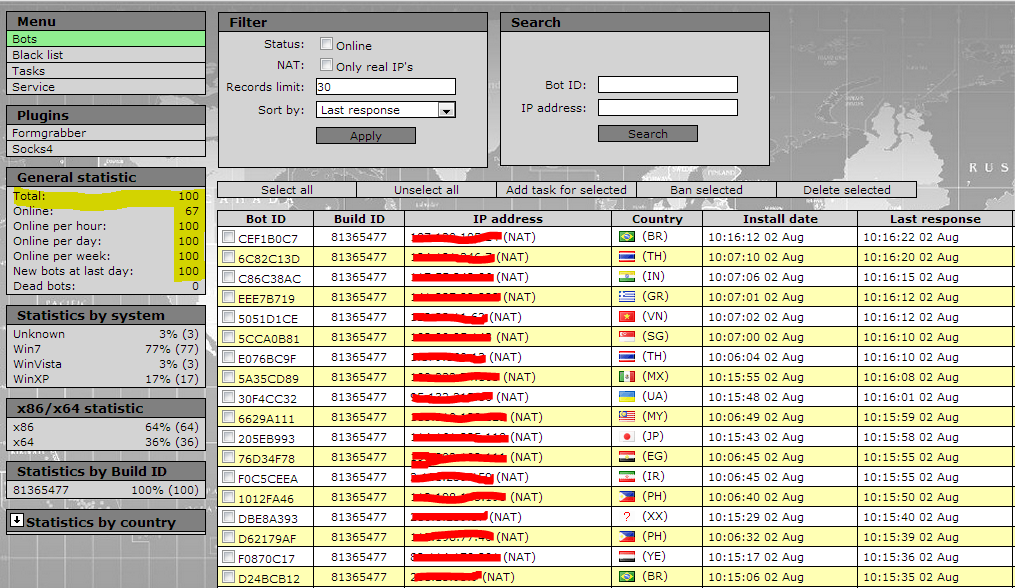
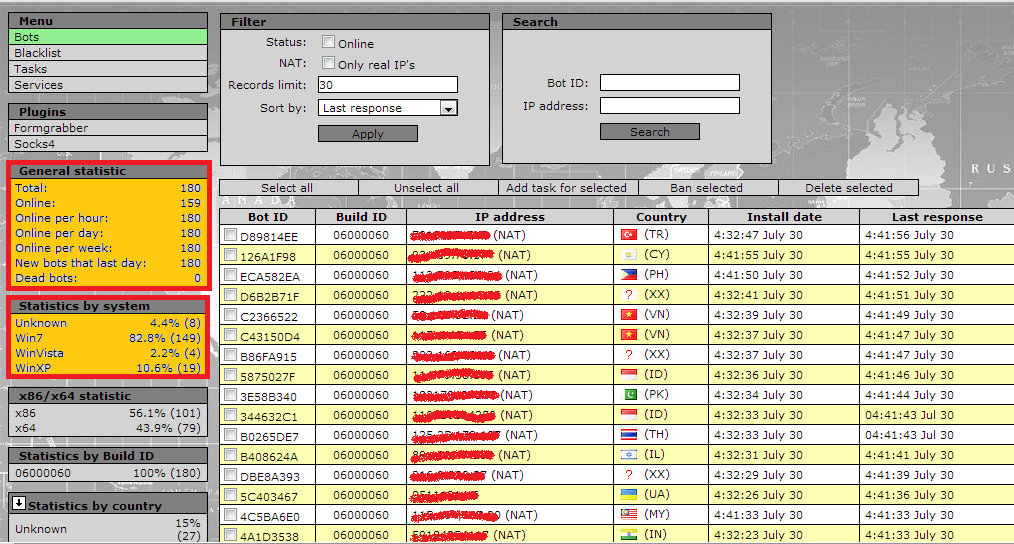
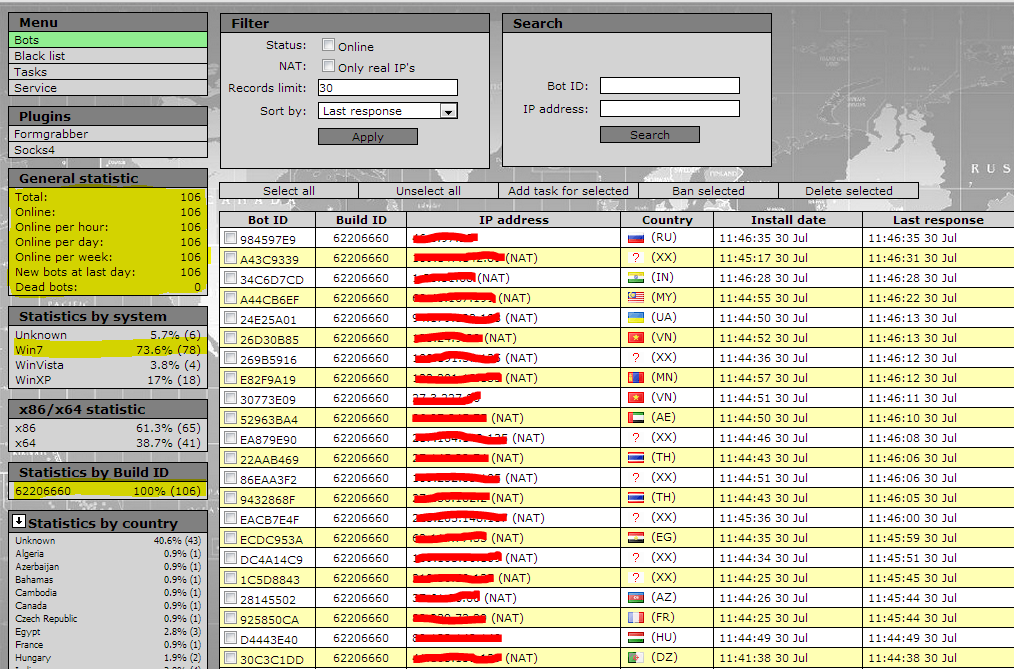
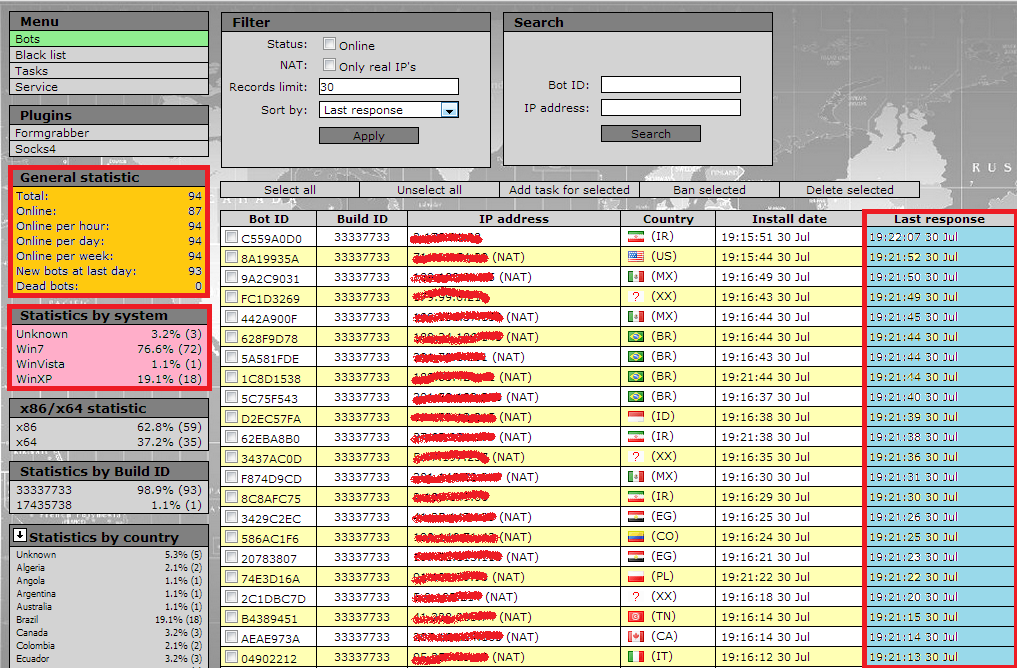
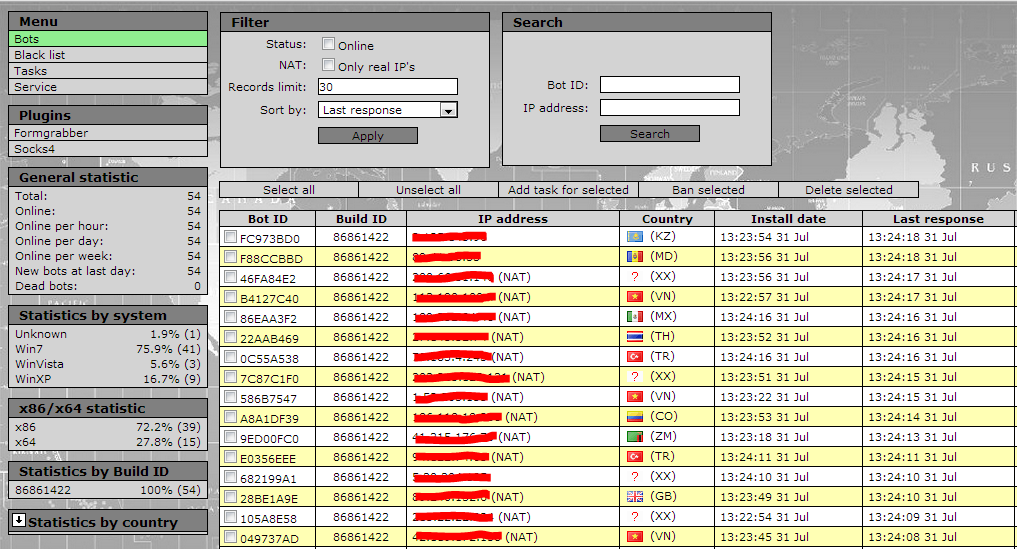 Such (international) underground market services demonstrate the ease of generating and operating beneath the radar
in 2013, where the size of the botnet is proportional with the
(indirectly) applied OPSEC (Operational Security), thanks to the fact
that such mini botnets are usually perceived as smaller threats compared
to sophisticated botnets causing widespread damage on a daily basis.
However, it’s these mini botnets that comprise a huge percentage of the
botnets operated by adversaries launching targeted attacks online, and
it’s only a matter of time before the botnet masters behind them realize
the market potential of geolocated hosts in a specific region/country
of interest to their prospective customers.
Such (international) underground market services demonstrate the ease of generating and operating beneath the radar
in 2013, where the size of the botnet is proportional with the
(indirectly) applied OPSEC (Operational Security), thanks to the fact
that such mini botnets are usually perceived as smaller threats compared
to sophisticated botnets causing widespread damage on a daily basis.
However, it’s these mini botnets that comprise a huge percentage of the
botnets operated by adversaries launching targeted attacks online, and
it’s only a matter of time before the botnet masters behind them realize
the market potential of geolocated hosts in a specific region/country
of interest to their prospective customers.